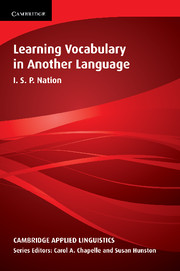Book contents
- Frontmatter
- Contents
- Series editors' preface
- Acknowledgements
- Introduction
- 1 The goals of vocabulary learning
- 2 Knowing a word
- 3 Teaching and explaining vocabulary
- 4 Vocabulary and listening and speaking
- 5 Vocabulary and reading and writing
- 6 Specialised uses of vocabulary
- 7 Vocabulary learning strategies and guessing from context
- 8 Word study strategies
- 9 Chunking and collocation
- 10 Testing vocabulary knowledge and use
- 11 Designing the vocabulary component of a language course Goals
- Appendixes
- References
- Subject index
- Author index
4 - Vocabulary and listening and speaking
Published online by Cambridge University Press: 05 October 2012
- Frontmatter
- Contents
- Series editors' preface
- Acknowledgements
- Introduction
- 1 The goals of vocabulary learning
- 2 Knowing a word
- 3 Teaching and explaining vocabulary
- 4 Vocabulary and listening and speaking
- 5 Vocabulary and reading and writing
- 6 Specialised uses of vocabulary
- 7 Vocabulary learning strategies and guessing from context
- 8 Word study strategies
- 9 Chunking and collocation
- 10 Testing vocabulary knowledge and use
- 11 Designing the vocabulary component of a language course Goals
- Appendixes
- References
- Subject index
- Author index
Summary
This chapter looks at opportunities for vocabulary learning through the oral skills of listening and speaking. With careful thought and planning, listening and speaking can be important means of vocabulary growth.
What vocabulary knowledge is needed for listening?
Learning vocabulary through listening is one type of learning through meaning-focused input. Learners would need at least 95% coverage of the running words in the input in order to gain reasonable comprehension and to have reasonable success at guessing from context. A higher coverage of around 98% (one unknown word in every 50 words, or 2 to 3 unknown words per minute) would be better (Hu and Nation, in press). Studies of spoken language, especially colloquial spoken language used in informal situations, indicate that a vocabulary of around 2,000 word families can provide over 95% coverage (Schonell, Meddleton and Shaw, 1956). More formal academic spoken language would probably require knowledge of the Academic Word List, although this still remains to be investigated.
Cummins (1986) attempted to incorporate the skills of L2 faceto-face communication and performance on L2 cognitive/academic tasks into a construct of ‘language proficiency’, in order to account for the relationship between language proficiency and academic achievement. Cummins used two continua.
Informal speaking skills are in the top left section, usually being cognitively undemanding (dealing with familiar topics) and context embedded (related to here and now). Academic discourse is in the bottom right being cognitively demanding (having a high information load) and context reduced (constructing its own mental reality).
- Type
- Chapter
- Information
- Learning Vocabulary in Another Language , pp. 114 - 143Publisher: Cambridge University PressPrint publication year: 2001

